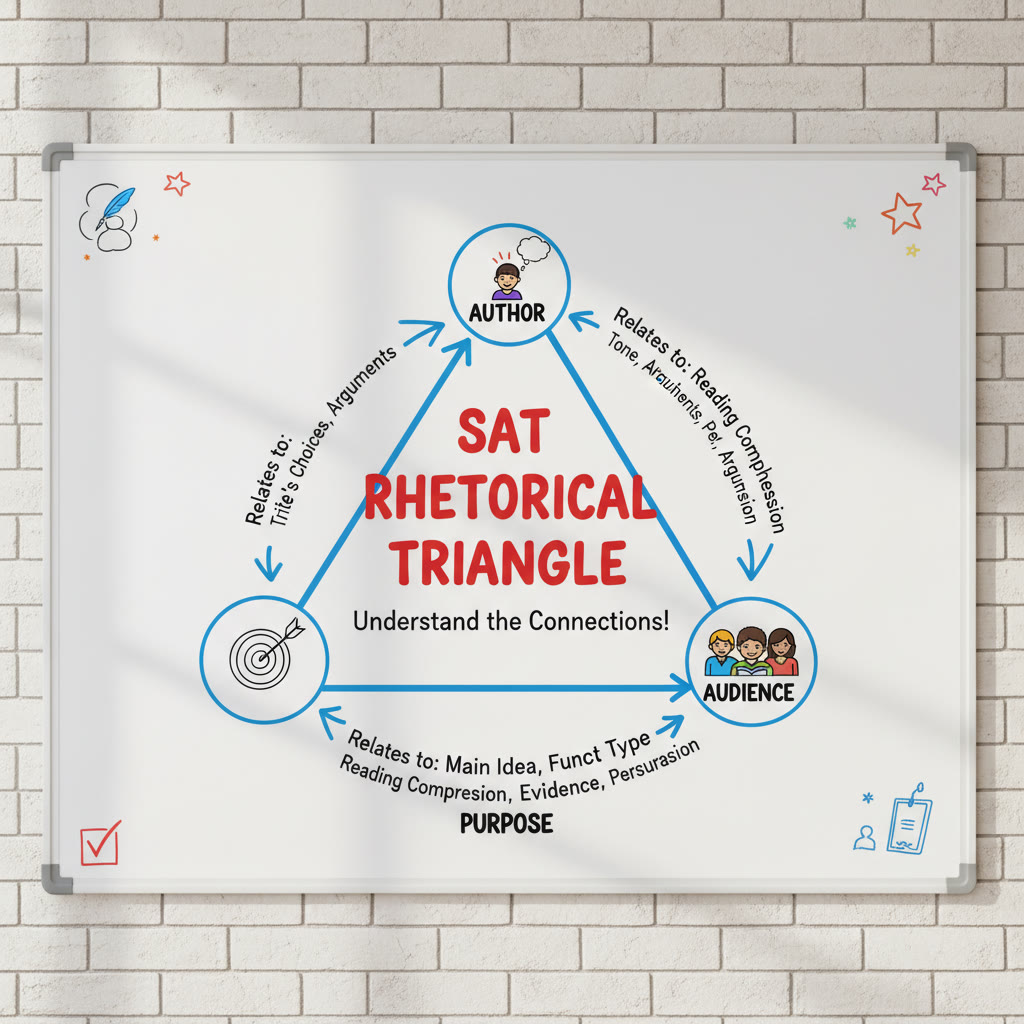Why Rhetorical Skills Matter on the SAT Writing Section
When you sit down for the SAT Writing and Language section, you are not only being tested on commas and verb forms. A large chunk of the section asks: can you think like a reader and an editor? Can you see the author’s purpose, anticipate the audience’s needs, and suggest changes that improve clarity, tone, and organization? These are rhetorical skills—and they separate students who mechanically correct grammar from those who improve communication.
The Essay section that once explicitly focused on rhetorical analysis has been retired, but its spirit lives on in the Writing and Language questions. You still have to evaluate how passages present ideas, use evidence, and guide readers. Learning these skills helps you on test day, and it also makes you a clearer writer for college and beyond.
What the SAT Means by “Rhetorical Skills”
On the SAT, rhetorical skills refer to the ability to analyze and improve the way information, arguments, and narratives are structured and expressed. The test looks for your capacity to:
- Identify author intent and audience expectations.
- Recognize and improve logical flow and organization.
- Choose effective word choice and tone for context.
- Assess whether evidence supports claims and whether transitions clarify relationships.
- Revise sentences or paragraphs to increase clarity and concision.
Categories of Rhetorical Questions on the Test
- Expression of Ideas — questions about organization, purpose, and development.
- Standard English Conventions — grammar and usage (these support rhetoric by making meaning clear).
- Analysis of Arguments — selecting or revising text so the reasoning or evidence is stronger.
- Style and Tone — matching wording and register to audience and purpose.
Read Like an Editor: A Step-by-Step Approach
One of the cleanest ways to approach the Writing and Language section is to develop two reading modes and switch between them:
- Rhetorical Read: Ask yourself, “What is this paragraph trying to do?” Look for purpose, audience, tone, organization, and evidence.
- Micro Read: Now zoom in for grammar, word choice, sentence-level clarity, and punctuation.
On a timed test, alternate between these reads quickly. Start with a fast rhetorical sweep: identify the author’s main point and the paragraph’s role. Then handle each question with the micro read. The test writers often tie sentence-level edits to a rhetorical reason, so this two-step approach keeps your answers grounded.
Common Rhetorical Moves and How the SAT Tests Them
Here are typical rhetorical moves you’ll encounter and practical ways to handle each one.
1. Purpose and Focus
What is the paragraph trying to accomplish? Is it providing context, presenting evidence, countering an objection, or concluding? Questions might ask you to insert or delete a sentence, or to replace a sentence so it fits the intended purpose.
Tip: For insertion or deletion questions, quickly label the sentence roles in the passage margin (Context, Example, Evidence, Counterpoint, Tie-back). Pick answers that keep the paragraph tight and focused on that role.
2. Organization and Transitions
Transitions reveal relationships: cause-effect, contrast, sequence, or addition. The SAT tests whether you can choose the transition that best reveals that relationship.
Tip: Look for signal words like however, therefore, consequently, similarly, and meanwhile. If a sentence breaks the flow, ask whether it needs repositioning or a different transitional phrase.
3. Development and Evidence
Does the passage support claims with relevant facts, examples, or reasoning? Sometimes the correct choice is the sentence that adds the most appropriate evidence or deletes an irrelevant detail.
Tip: Accept evidence that is specific and directly linked to the claim; reject anything that distracts the reader or undermines the logical chain.
4. Tone, Style, and Word Choice
Formal, informal, technical, or emotional — tone matters. A single word can tilt the passage toward sarcasm or sincerity. The SAT asks you to pick words that match the author’s purpose.
Tip: When in doubt, choose the option that maintains consistent tone and avoids extremes. Prefer neutral, precise words over hyperbole.
5. Concision and Redundancy
Academic writing on the SAT rewards clarity. If a sentence repeats itself or uses unnecessary words, the test often wants the concise version.
Tip: Cut the fluff. Shorter, clearer options are frequently correct—unless a longer option adds necessary nuance or detail.
A Mini Practice Passage and Walkthrough
Below is a short, original passage created in the spirit of SAT Writing questions. Work through it as you would in the test.
Passage: A city that once relied on river trade has seen a shift in its economy; as factories closed, service industries and tourism grew. The river’s warehouses, formerly a symbol of industry, were converted into galleries and cafes. However, the changes were not uniformly positive—some long-time residents felt nostalgic for the old jobs, and housing prices near the waterfront rose dramatically.
Sample Question (Rhetorical):
The author wants to make the paragraph’s contrast clearer between the city’s economic transformation and its costs to residents. Which revision best achieves this?
- A. Change “However, the changes were not uniformly positive—some long-time residents felt nostalgic for the old jobs, and housing prices near the waterfront rose dramatically.” to “Nonetheless, not everyone benefited: long-time residents missed their livelihoods, and waterfront housing prices soared.”
- B. Change “However, the changes were not uniformly positive—some long-time residents felt nostalgic for the old jobs, and housing prices near the waterfront rose dramatically.” to “Still, the transformations had drawbacks; some citizens missed the factories, while others welcomed the new art scene.”
- C. Delete the sentence entirely.
- D. Replace “However, the changes were not uniformly positive—some long-time residents felt nostalgic for the old jobs, and housing prices near the waterfront rose dramatically.” with “In spite of the positive developments, the past lingered in memory.”
Correct answer: A.
Why: Option A makes the contrast explicit (Nonetheless/not everyone benefited) and uses concrete phrasing (missed their livelihoods; housing prices soared). Option B weakens the contrast by making the drawbacks vague and splitting sentiment unevenly. Option C removes an important rhetorical counterpoint. Option D is too vague and doesn’t address the economic impact.
Examples: How Small Edits Affect Rhetorical Meaning
Below is a short table that summarizes common rhetorical problems on the SAT, what they look like in a passage, and quick fixes you can apply during the test.
| Rhetorical Problem | What It Looks Like | Quick Fix |
|---|---|---|
| Unclear Purpose | A sentence feels off-topic or interrupts the flow. | Choose to delete or relocate the sentence so each paragraph maintains one clear role. |
| Weak Evidence | Claim is followed by anecdote or vague phrasing instead of relevant facts. | Select the choice that adds specific, relevant support or reject the vague option. |
| Poor Transition | Relationship between sentences is confusing—cause, contrast, or sequence is unclear. | Pick the transition that precisely signals the relationship (however, consequently, similarly). |
| Inconsistent Tone | Word choice shifts from formal to colloquial without reason. | Opt for consistent register—usually formal or neutral, depending on passage. |
| Redundancy | Repeated ideas or unnecessary modifiers. | Choose concise wording unless extra detail is necessary for clarity or emphasis. |
Practical Strategies and Shortcuts
You don’t need to be a master rhetorician to score well. These practical moves will get you far:
- Annotate fast: In the margin note the passage’s purpose in one or two words. That mental label guides every answer.
- Listen for verbs: Strong verbs often reveal the author’s stance. Swap passive or vague verbs for active, precise ones when choices demand it.
- Prefer specificity: When two options are grammatically correct, usually the more specific, relevant one is right.
- Use elimination well: Wrong answers often introduce irrelevance, change tone, or create logical gaps.
- Practice with timing: Build stamina with mixed sets: 10 rhetorical questions, 10 grammar questions, repeat.
Common Traps to Avoid
Test writers want to catch students using intuition instead of analysis. Here are traps to watch for:
- Choosing a word because it sounds fancier: Fancy doesn’t equal precise. Pick clarity over style for its own sake.
- Keeping a sentence because you like it: If it doesn’t serve the paragraph’s purpose, it’s probably wrong.
- Over-editing in the wrong direction: Sometimes an answer that looks cleaner actually removes necessary nuance or support.
- Missing shifts in perspective: A passage may switch focus between the author’s background, a person’s anecdote, and statistical evidence; each shift requires the correct transitional signal.
How to Practice Rhetorical Skills Effectively
Improving rhetorical mastery is like training for a sport: focused drills beat aimless repetition. Here’s a week-by-week plan you can adapt depending on how much time you have.
Sample 6-Week Plan (3–5 hours per week)
- Weeks 1–2: Read short opinion and explanatory articles. Annotate purpose, audience, and main moves. Do timed practice sets of 15 Writing and Language questions twice a week.
- Weeks 3–4: Focus on transitions, evidence questions, and insert/delete items. Do targeted drills: 20 insertion/deletion questions per session and review why each wrong choice fails rhetorically.
- Weeks 5–6: Full-section practice under timed conditions. Review mistakes by categorizing them: purpose, tone, evidence, or grammar. Strengthen weak areas and simulate test-day conditions.
Using Tutors and Tools the Smart Way
There’s enormous value in guided practice, especially when it’s tailored to your specific patterns of error. If you repeatedly miss transition questions, focused sessions on organization will pay off faster than random practice.
Sparkl’s personalized tutoring, for example, can offer 1-on-1 guidance, tailored study plans, expert tutors, and AI-driven insights to pinpoint the rhetorical moves you miss most. Working with a tutor helps you transform mistakes into targeted practice—so every hour you spend studying becomes more productive.
Real-World Benefits of Rhetorical Skills
These aren’t just test skills. The rhetorical awareness you build for the SAT Writing section translates directly to college essays, research papers, and everyday communication:
- Clearer arguments in class discussions.
- Stronger, more persuasive essays for applications and scholarship efforts.
- Better professional writing—emails, reports, and presentations.
When you practice rhetorical reading, you’re training your brain to spot relevance, tighten reasoning, and choose words that make meaning unmistakable. That’s a lifelong advantage.
Quick Reference Cheatsheet
Keep these quick rules in your back pocket during practice and review them the night before your test:
- Ask “why is this sentence here?” for every problematic sentence.
- Prefer the choice that keeps or improves the paragraph’s central purpose.
- Choose transitions that clearly reflect the relationship (contrast, cause, example, addition).
- Favor precision and concision—unless nuance is necessary.
- If two answers are grammatically equal, pick the one that better matches tone and audience.
Final Thoughts: Confidence Through Intentional Practice
Rhetorical skills on the SAT Writing section are learnable. They reward curiosity: the more you read with an editor’s eye, the faster you’ll parse purpose and improve passages. Practice deliberately, review errors with an eye for patterns, and gradually the questions that once felt like traps will become routine.
If you want to accelerate that progress, consider pairing your self-study with targeted coaching. Sparkl’s personalized tutoring can provide a clear diagnosis of your rhetorical weak spots and help you build a tailored study plan—combining expert human feedback with AI-driven insights so your practice sessions are efficient and meaningful.
Image Suggestions


Wrap-Up: Make Rhetoric Your Strength
Walk into the Writing and Language section knowing you’re not being asked to memorize infinite grammar rules. You’re being asked to think: What’s the author doing, and how will this change make the passage better for its readers? Treat each question like a tiny editing problem. Keep your focus on purpose, clarity, and evidence. With steady practice and the right feedback—whether from careful self-review or personalized tutoring—you can turn rhetorical questions from stumbling blocks into scoring opportunities.
Good luck, and trust the work: every paragraph you dissect now makes your future writing clearer and your test scores stronger.













No Comments
Leave a comment Cancel